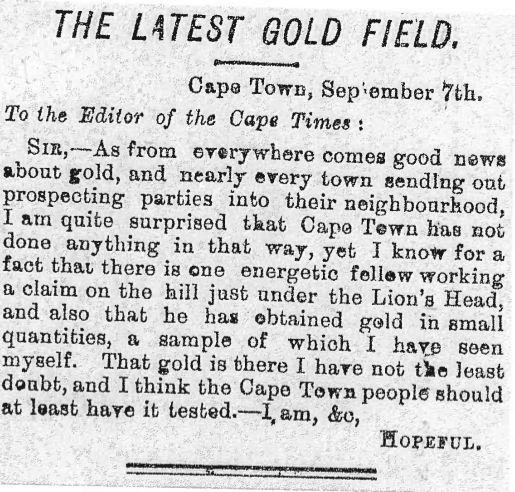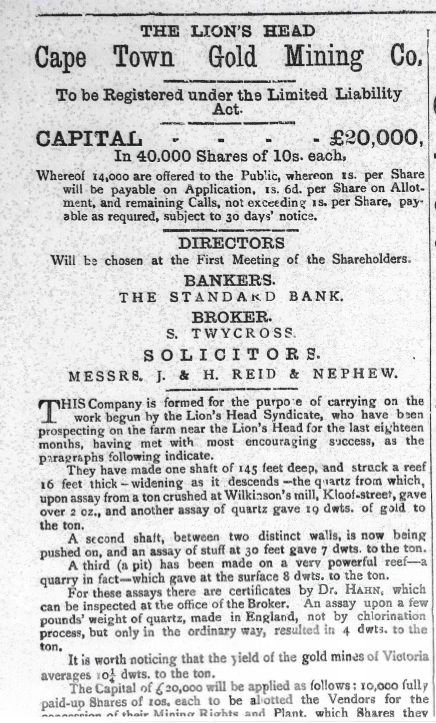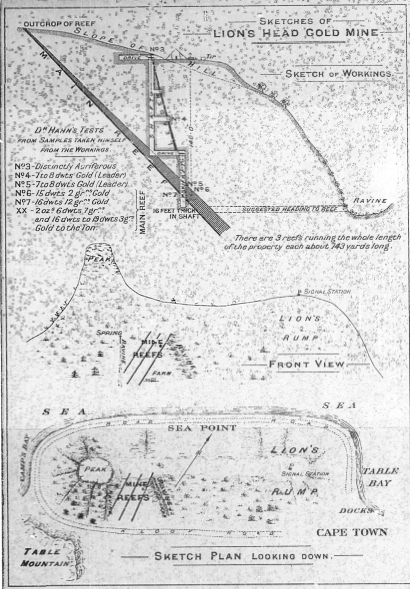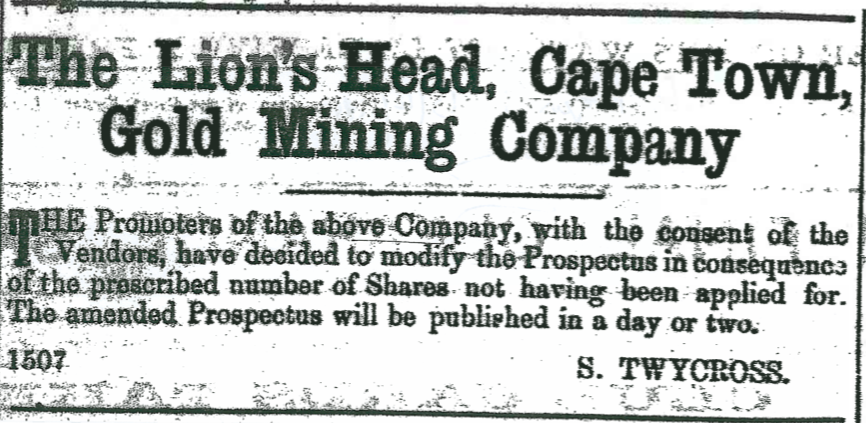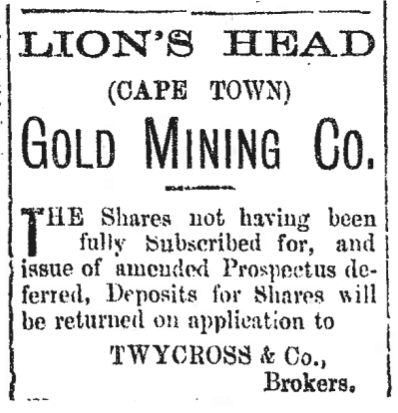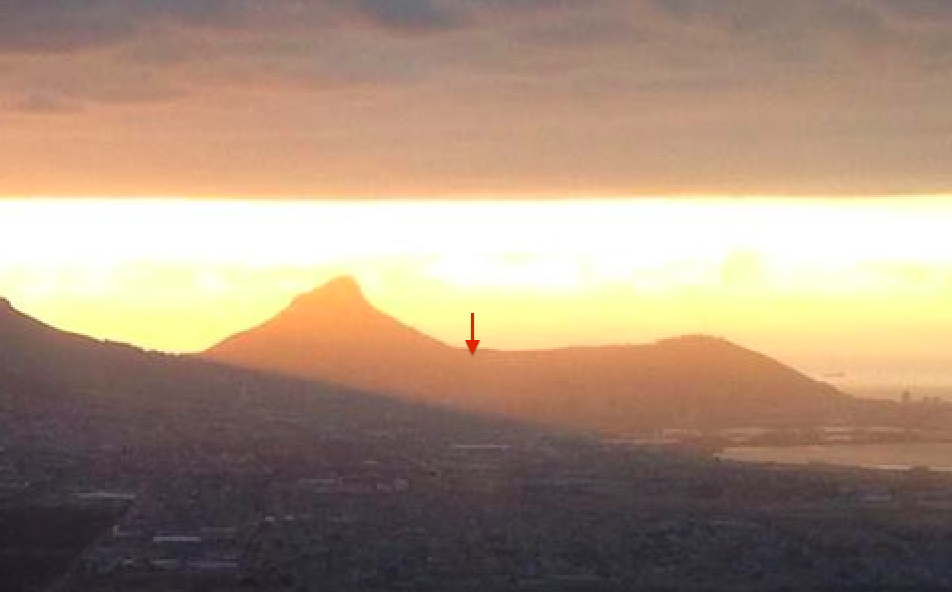
Disclaimer: Any views expressed by individuals and organisations are their own and do not in any way represent the views of The Heritage Portal. If you find any mistakes or historical inaccuracies, please contact the editor.
We are incredibly excited to publish this superb article on a little known piece of Cape Town and South African Mining History. In the paragraphs below Professor Peter Spargo traces the rise and fall of a gold mining venture on Lion's Head. The article was originally published in the June 2015 edition of the Bulletin of the National Library of South Africa.
The discovery in March 1886 of the Witwatersrand Main Reef by the Australian prospector George Harrison did not come as a complete surprise as a number of promising gold deposits had already been discovered in the Transvaal some time before.1 However there can be little doubt that, in spite of what Andrew Geddes Bain called “the golden mania” that was sweeping the Colony at the time,2 most readers of the Cape Times of Thursday 9 September 1886 would have been astonished to find there a letter from one ‘HOPEFUL’ - under the eye-catching heading THE LATEST GOLD FIELD - announcing that “there is one energetic fellow working a claim on the hill under the Lion’s Head, and … he has obtained gold in small quantities, a sample of which I have seen myself” 3
The Letter that appeared in the Cape Times
Precisely when and by whom gold was first discovered on Lion’s Head will probably never be known, although a report of 4 May 1887 by P D Hahn, Professor of Chemistry at the South African College (later to become the University of Cape Town), places the newspaper report of September 1886 into context:
“In August 1886, a few persons, interested in the search for gold formed themselves into a syndicate for the purpose of prospecting for gold on the Lion’s Hill, and obtained permission from the Hon. J. H. Hofmeyr, M.L.C., 4 to prospect on his farm on the Kloof Road on the slopes of Lion’s Head.” 5 However, it was more than two months before mention is first made of the Lion’s Head Syndicate, “who have been prospecting on the farm near the Lion’s Head for the last eighteen months.”, i.e. from about May 1886, when one must assume that serious prospecting on Lion’s Head began. 6
Mining commences: an encouraging beginning
A fortnight later, under the heading ‘THE GOLD EXCITEMENT’, came the dramatic news that “under Lion’s Head a shaft is being sunk, and on the quartz a few specks, said to be gold, are seen.” It is significant, however, that the item ended with the caution that “There had been no scientific analysis of the quartz.” 7 By 29 November 1886 further progress was reported, “The shaft which is being sunk beneath the Lion’s Head has now reached a depth of about sixty feet, and those who were sinking it are so satisfied with indications that they have purchased from Mr. Hofmeyr that portion of the estate on which they are working. The quartz which is being taken out is close grained and hard …. and is studded with pyrites, which are described as auriferous. We have not heard that any analysis establishes that fact.” 8
Four days later came the surprising announcement that not only had fifty acres of land on the slopes of Lion’s Head been purchased for the mine but that hopes were so high “as to induce a number of gentlemen to send one of their members to England by today’s mail with the object of forming a company.” 9 Although the ‘gentlemen’ were not named, and the outcome of their emissary’s visit to England is not known, a week later came another report that a sample of rock from the mine had been sent to England for assaying by a prominent London firm, and had produced positive results:
The Lion’s Hill Gold Field may yet reward the diligent prospectors’ enterprise. A box of quartz, taken within a foot or two of the surface, was recently sent to Messrs. Savory & Co., of London, for assay, and the report received from that firm by the last mail shows the following result:
Fine gold 2 dwts. 12 grs. per ton 10
Fine silver 7 dwts. 12 grs. per ton.11
Other good news was also to hand for some fortnight later, under the heading ‘Prospecting on Lion’s Head’ came the first major press description of the mining operations, containing the encouraging news that the syndicate
… have at length, it is stated, come upon stone containing gold which is easily visible under the microscope. Messrs. De Vries & Co., the chemists at the corner of Grave and Longmarket-streets, have a number of specimens of rock from various depths, those coming from the deeper levels being very heavy, and evidently containing a large quantity of metal.12
Nevertheless the same article sounded a warning that ‘the quantity of stone tested was so small that the analysis can only be considered valuable in that it demonstrates the fact of the existence of gold and silver in the stone. As a quantitative analysis it is, of course, worthless.’ On a more positive note it also noted that the shaft had by now reached the respectable depth of ninety feet and ‘the further it goes the heavier the rock becomes.’
Mining ventures are no strangers to rumours and this one was no exception. “A report has got about to the effect that the syndicate intend floating a company with a fabulous capital in London to purchase and work the mine. There is no foundation, however, for this rumour, the present owners being convinced that it will pay them better should the assay prove favourable to work the mine on its merits.”12
Sampling and sealing the ore for assaying
Perhaps anxious to establish the legitimacy of the mine in the eyes of a critical public - and no doubt especially future investors – the Syndicate now staged a well-organised publicity event: the gathering and sealing of a substantial sample of the ore from the mine in the presence of none other than the Hon. Frederick X Schermbrucker who, as Commissioner of Crown Lands and Public Works, was an important official in the Cape Colonial administration and would ensure its legitimacy. Described at length on the same day in both the Cape Times and the Cape Argus this must be an event unique in the industrial history of Cape Town:
THE LION’S HEAD SHAFT.
AN OFFICIALLY GUARANTEED TEST.
_____________________________________
On Saturday afternoon a party of gentlemen, friends of the members of the syndicate which has been prospecting on the Lion’s Head for some time past, left town, accompanied by most of the prospectors, for the purpose of inspecting the workings, and seeing a certain quantity of rock blown out, and packed and sealed in the presence of the Commissioner of Crown lands and Public Works. [The road] leads to the farm which was purchased by the syndicate a few days ago. An astonishing bank of debris in the gully which marks the scene of the workings, and which has been taken out of the shaft, consists of thousands of loads of shale. The works consist of a drive, or tunnel, some eight feet high by ten broad and twenty deep into the side of the hill. A few feet from the entrance to the tunnel the mouth of the shaft opens. This is operated by means of an ordinary windlass, and extends at present to a depth of nearly ninety feet. The reef is followed, widening steadily from a few inches in breadth at the opening to some five feet at the bottom of the shaft. Two drives have been run at different levels in the main shaft, but the intention of the syndicate is to continue sinking through the reef, as the stone grows heavier. About three o’clock, the Commissioner of Crown Lands, and party arrived. Mr. Schermbrucker signified his intention of descending the shaft before the shots were fired, in order to convince himself and the public that everything had been done in a thoroughly straightforward manner; and after having divested himself of his coat and white hat, he gallantly set one foot in the bucket, laid hold of the rope and gave the word to lower away. After spending a quarter of an hour in examining the underground workings, the Commissioner was shown samples of the stone from various levels in the reef, and expressed himself much pleased with its appearance. Two shots, each of four dynamite cartridges, were fired at the foot of the shaft, causing a slight trembling of the earth beneath the feet of the surface party, until the foreman announced that the fumes of the dynamite had cleared away and that the Commissioner could descend safely. Down the shaft again went Mr. Schermbrucker, reporting that the shots had displaced a large amount of rock. A sack was attached to a spring weighing-machine, Mr. Schermbrucker standing close by, and watching the operation intently. The sack being filled with 210 lbs. of ore was securely tied, on which the Commissioner affixed his official seal. He said that now everything possible had been done to prevent any doubt in the mind of the public as to the genuineness of the test that was about to be made. He had seen the ground before and after the shots were fired, and had watched the filling of the sack, which would be sent home to the assayers, he sending a duplicate impression of the seal from his office, so that they could easily see if it had been tampered with. The sealed bag, together with other bags containing sufficient stone to make up a ton, will be sent home to Messrs. Savory & Sons, of Lombard-street, London, the Assayers to the Bank of England, by Wednesday’s steamer; and the result of this analysis may be expected in about nine or ten weeks’ time. It is estimated that half an ounce of gold per ton would return a handsome profit, and if, as the first analysis showed, the gold should be accompanied by a much larger proportion of silver, an even smaller percentage of gold to the ton will leave a margin. By the result of that sack of stuff, the future of the Lion’s Head syndicate will have to stand or fall. The syndicate have not come to the public for anything; nor will they do so, until the existence of payable gold in the rocks on the Lion’s Head has been established as an incontrovertible fact.”13
After a somewhat cautious first report,14 six weeks later followed the dramatic announcement that a cable had been received stating that the ore forwarded to England, had assayed at twenty-two grains to the ton.”15 While confirming that a gold deposit of some sort had indeed been discovered, when this new result was compared to the two results of 8 January16 it was significant that the earlier ones were some 3 and 8 times higher respectively. Nevertheless, it is difficult to believe a letter in the Cape Times from ‘Caveat Speculator’ (“Let the speculator beware!”) claiming that when he was “chatting with a man at the docks loading the quartz being sent “home” for assay, the man told him that it is being sent overseas for assay ‘ … to make the shares go up a bit out here.’”17
P D Hahn’s further assay results
But good news was at hand, especially as it involved P D Hahn, the highly competent and well regarded professor of Chemistry at the South African College, who had assayed 100 lb. of quartz ‘taken from what is supposed to be the main reef of the mine’ at over two ounces per ton, 18whose report was dated 7 June but only published on the 27th.19
The following day the ten members of the Lion’s Head Syndicate were announced: A P de Villiers, J S le Sueur, J Mills, L Lazarus, C W Barnes, B A de Vries Jr, M C de Vries, C J Olley, L Warshawsky and D Fock.20 It is noteworthy how few of the leading Cape businessmen of the time appear in the list, perhaps showing that the Cape Town financial establishment had less faith in the Lion’s Head venture than in the rapidly expanding mines on the Witwatersrand, in which they were investing heavily. Nevertheless it is interesting to note that after their visit to the mine on Saturday 11 June Attorney General Sir Thomas Upington and three members of the Legislative Assembly “expressed themselves very well satisfied with their inspection.” (The Premier, Sir Gordon Sprigg, had announced his intention to accompany the party, but was detained in town by pressing business.) 21
If this was not sufficient reassurance to the public as to the health of the mine, this surely came with the important announcement less than a week later:
LION’S HEAD GOLD MINE. – We learn that the Lion’s Head Gold Mining Syndicate has decided to float the concern as a limited liability company, in consequence of a highly satisfactory report presented by Dr. Hahn, as the result of a personal inspection in the mine, and a free picking of the quartz. Analyses have shown yields varying from 14 dwts. to 2 ozs. to the ton. 22
A week later P D Hahn’s report, in the form of a heretofore unpublished letter of 4 May to L Warshawsky, who was presumably the leading member of the syndicate, stated that after washing and amalgamation with mercury “from 80 lbs. of the sample have been obtained 30½ grains of gold; this corresponds with 2 ounces, 1 dwt. 6½ grains of gold per ton of 2,000 lbs. Nearly 20 lbs. of the sample have been assayed by a preliminary test with the same result.” This very positive result was followed by a second letter from Prof. Hahn, this time to B A De Vries, a local pharmacist and active member of the Syndicate, reporting on Hahn’s analysis of seven samples of quartz from what he calls “different reefs”, which he had taken when visiting the mine on 25 May.
The samples were widely spread, as follows: two from the surface, one each from the entrance, “about the middle”. “near lowest part”, and two from the main reef at a depth of 140 feet. After noting that the shaft appears to be on the contact zone of the clay slate and the granite, Hahn pointed out that the existence of much iron pyrites in the numerous veins of quartz, which in several places are exposed on the surface. The assays showed that while one of the surface samples showed no gold, the two others near the surface were “distinctly auriferous”, the next two contained “a very fair amount of gold”, while the two lowest, i.e. at 140 ft., contained 13 dwts. 11 grains per ton and 14 dwts. 16 grains per ton respectively.
Hahn cautioned, however, that the nature of the ore was such that the extraction of the gold would have to be carried out by the Cassel Process which, involving as it did chlorination, was more complicated than the simpler amalgamation process using mercury. (This released the particles of gold from the layer of iron sulphide in which they were encased, thereby giving truer results.) But he ended on a very positive note: “I am of the opinion that the contact-zone between granite and slate from Sea Point to the neck between Devil’s Peak and Table Mountain is auriferous, and that gold will be found everywhere in this zone.”23
But many were unconvinced by Hahn’s arguments and during July the columns of both the Times and the Argus saw a steady stream of letters, some couched in the most intemperate language, expressing both extreme doubt concerning the merits of the mine as well as the true intentions and integrity of the syndicate! Most of these were answered very positively either by P D Hahn or by C J Olley, one of the members of the Syndicate and now described as its “hon. secretary”. On 8 July Hahn made the extraordinary – and of course incorrect - claim that “the reefs on the Lion’s Head taken as a whole are richer than any one of the Knysna reefs hitherto discovered. … I know it is a fact as I had taken the samples myself, and I have found a very fair quantity of free visible gold in some of the quartz veins which traverse the metamorphosed slate.”24
On 21 July came the announcement, no doubt intended to reassure investors, that “Several tons of quartz from the Lion’s Head mine were forwarded to England by the mail steamer yesterday, for the purpose of being thoroughly tested, and as fast as the rock can be blasted out, more will be sent, until the total reaches twenty tons. The matter has been taken up by Mr. L. Wiener, M.L.A., and other influential merchants, by whom the stuff has been forwarded.” 25
Offer of shares in the Lion’s Head (Cape Town) Gold Mining Company
The intention of the Syndicate was clearly to develop the mine further – no doubt driven by the urgent need of a cash injection in order to continue mining, which hitherto had been paid for out of their own pockets – and on 19 November there appeared in the weekend edition of the Cape Times the lengthy prospectus of ‘The Lion’s Head Cape Town Gold Mining Co.’26 Over the next fortnight this appeared some ten times. The company was to be registered under the Limited Liability Act with a capital of £20 000 in 40 000 shares of 10s. each, of which 14 000 were to be offered to the public, with 1s. per share being payable on application. The advertisement of 23 November also included a diagram showing ‘the extent of the workings already undertaken by the Syndicate.’ 27
The lengthy prospectus of ‘The Lion’s Head Cape Town Gold Mining Co
Sketches of the Lion's Head Gold Mine
A notable feature of the share offering was that “10,000 fully paid-up Shares 10s, each to be allotted to the Vendors [i.e. the members of the syndicate] for the concession of their Mining Rights and Plant, which shares they agree shall be endorsed “Not negotiable for 12 months unless a dividend is paid before then,” in order to show their perfect bona fides.” The assay results of 2 ounces and 19 dwts. of a ton of ore “crushed at Wilkinson’s mill, Kloof-street” were quoted, but the same number of the Argus also contained a letter from S Twycross, the company’s broker, reminding readers of the distressing news that “The five tons of quartz sent to England in July, to be tested by chlorination process, to the great disappointment of the Syndicate was not so tested, but, as mentioned in the prospectus, an assay upon a few pounds’ weight by ordinary process [i.e. amalgamation with mercury] was made, and resulted in 4 dwts. to the ton.” 28 Thus a reliable assay on which to base an estimate of the mine’s future, and on which the syndicate was clearly depending, was still lacking.
A few days later a sub-leader in the Argus in wishing the mine well was understandably cautious with regard to its future, ‘Whether it is sufficiently auriferous to pay for working we take leave to say has yet to be determined …’ At the same time it expressed some concern regarding the way in which shares were to be allocated and held. 29
Then followed another exchange of letters in the press, mostly but by no means all critical of the syndicate’s plans and the future of the mine. All were answered in a measured and conciliatory manner by C J Olley or S Twycross. One even quoted Thomas Bain’s opinion that ‘the richest quartz had not been reached’.30 A news item also reported the Dean of Cape Town’s displeasure at Capetonians investing in the “gold share mania” in Barberton and Johannesburg rather than in “the Lion’s Head Gold Mine, which was near at hand, and might benefit us locally.” 31
A failed share offer and the promise of a revised prospectus
The share offer had clearly met with an exceedingly cool reception, as on 13 December – a scant three weeks after the first publication of the offer – it was announced that “the Company, with the consent of the Vendors, have decided to modify the Prospectus in consequence of the prescribed number of Shares not having been applied for. The amended Prospectus will be published in a day or two.” 32
This was no doubt a grievous blow to the whole venture for without a further injection of money mining clearly could not continue and the whole enterprise would come to a halt. There is no evidence that the promised “revised prospectus” was in fact ever issued or, if it did, it was not published, or even mentioned, in the local press. The following day the weekly satirical column “Saturday Sallies”, after describing the venture thus far as “an attempt to extract money from the pockets of the public”, mentioned “the meeting that was lately held for the purpose of ascertaining what could be done in the matter”, and at which it had been decided to take a sufficient quantity of ore and send it to Freibourg in Germany for treatment, “ores of a similar character being made to pay there, so it is said, on little more than a single pennyweight to the ton.” 33
The End of the Road
These plans to publish a revised prospectus clearly came to naught for on the same day, 14 January 1888, there appeared the final press notice issued by the company. This informed shareholders that “The Shares not having been fully subscribed for, and [the] issue of [an] amended Prospectus deferred, Deposits for Shares will be returned on application to Twycross & Co., Brokers.” 34 The venture had failed.
The Final Press Notice
Then would have followed the normal procedures related to the closing of a mine: if there were any funds remaining the workers would have been paid off, the hoisting and other machinery, including the drills and hand tools, would have been sold, essentially at scrap prices, and the site simply abandoned.
Sadly - no doubt a reflection of the times – in none of the many press reports on the mine was there any mention of the men who laboured there: and they remained faceless and undescribed to the end: we have no clue as to who and how many miners were employed, where they came from, how much they were paid, how they were fed, where they lived and how many, if any, were killed or injured.
As the company had never been formally registered under the Limited Liability Act, and syndicates were not required to be so registered, the winding up would have involved few legal formalities. The Western Cape Archives contain only one minor document relating to the mine – a bond for £950 35 – and the National Library of South Africa catalogue shows nothing. Astonishingly, no photographs of the mine are known to exist. To appropriate T S Elliot’s memorable phrase, the mine ended not with a bang but a whimper.
The aftermath...
The syndicate, although presumably now dormant, must have lingered in existence after the mine ceased operating, for in 1892 they disposed of the farm which they had bought with such high hopes five years before.36
The previous year the Cape Town City Council Public Works Committee had decided that the open shaft on Lion’s Head was dangerous and instructed the “Gold Syndicate” to fill it in or face prosecution. However, nothing was done and the shaft was only finally filled in in 1951 after a fire-fighter had narrowly escaped falling into it.37
Today all that remains of the mine is a depression where the material used to fill in the shaft in 1951 is settling with time, some terraces and low stone walls, a few piles of excavated waste now covered with thick fynbos38 - and the words “Old Gold Mine” on Peter Slingsby’s 1:20,000 map of Table Mountain.
Why did the venture fail?
Was there really gold on Lion’s Head? Confused as they were, the assay results certainly confirmed the existence of gold-bearing quartz as the shaft was deepened. (This comes as no surprise as gold is well known to occur in many places in the quartz at the interface between the granite and Malmesbury Group shales, as here.) Unfortunately the concentration of such gold is frequently erratic and unpredictable and the fact that the various assay procedures adopted by the Syndicate went sadly awry did little to fill potential investors with confidence in the viability of the whole enterprise. Finally, the syndicate hoped for the support of local investors at almost precisely the same time as the numerous, and extremely alluring, gold mines on the Witwatersrand were being floated. As a result money was flowing north from the Cape in very substantial amounts, thereby severely restricting the availability of capital required for investment in a local venture such as this. (Mabin estimates that between 1886 and 1889 Cape residents invested some £6 000 000 in the Transvaal gold mines.39) Hence the weak response to the initial share offering. Given these two factors it was almost predictable that the venture would not succeed, as indeed it didn’t. Sad in some ways but who would really welcome a functioning, substantial mine in one of the most beautiful areas in the world?
The Sea Point Gold Mine
No account of mining on Lion’s Head would be complete without some mention of a small contemporaneous, but now almost completely forgotten, venture on the Lion’s Rump, i.e. on the slopes of Signal Hill overlooking Table Bay. Sometime in 1887 one Frederick Phillips was granted a permit to prospect on the ‘Sea Point side of Lion’s Rump and Neck’.40 His work, or that of other prospectors, must have been sufficiently encouraging to justify the formation of a syndicate for on 5 March 1887 the Cape Argus reported that ‘The Sea Point Gold Mining Syndicate, who have been quietly at work for some time past, believe that they have succeeded in striking the reef on their side of the Lion’s Head. Some quartz was crushed and panned out yesterday afternoon.’ 41
Mining operations must have been prosecuted with some vigour, for an 1888 report by J Le Sueur, who we have already met as a member of the Lion’s Head syndicate, described how 800 ft. above sea level a horizontal tunnel 56 ft. in length had been driven into the Lion’s Rump above Sea Point. At the same time a 30 ft. shaft was sunk “about 150 ft. lower than the tunnel slightly to the east.”42 However, work was stopped pending the outcome of the assay of the ore from the Lion’s Head mine and when these results proved to be disappointing it was not resumed. No further details relating the mine has been found and today the horizontal shaft, some 2m by 2m in cross-section and c. 20m in length, is still accessible above Sea Point. However, the site of the vertical shaft has not been located and is presumably obscured by the heavy growth in the area.
Peter Spargo 2015
_________________________________________________
1 A P Cartwright, The Gold Miners. (Cape Town: Purnell, 1962)
2 A. G. Bain, ‘Geology of South Africa’, Eastern Province Magazine, vol. I, No. 8, April 1857, pp. 396-507.
3 Cape Times, 9 September 1886.
4 Member of the Cape Legislative Council. Jan H. Hofmeyr was a prominent Cape Town resident of the time.
5 CAPE OF GOOD HOPE. 'Reports on the Knysna Gold Fields, and on Gold Mining and Prospecting in the Colony for the Year 1887.' Cape Town 1888. [G48 –’88; Annexures v. 2]. No. 3. Report of the Civil Commissioner, Cape, on Gold Prospecting or Mining in the Cape Division. Annexure I.
6 Cape Times, 23 November 1887, p. 2/2-3.
7 Cape Times, Saturday 25 September 1886, p. 3/7.
8 Cape Times, Monday 29 November 1886, p. 3/3.
9 Cape Times, 1 December 1886, p. 3/2.
10 “dwt” (pennyweight) and “grn” (grain) are units in the Troy scale of weight, previously widely used in describing the value of ores containing precious metals. On this scale 1 pennyweight = 24 grains and 1 ounce = 480 grains. In SI units, a pennyweight = 1.55g and a grain 0.065g. Today SI units, i.e. grammes per ton (g/ton), are almost universally used in expressing assay results. Thus 2 dwts 12 grs per ton and 7 dwts 12 grs. per ton would be equivalent to 4.28 g/ton and 11.64g/ton respectively.
11 Cape Times, Saturday 8 January 1887, p. 2/9.
12 Cape Argus, Thursday 20 January 1887, p. 3/5.
13 Cape Argus, Monday 24 January 1887, p. 3/1; repeated in the Cape Argus, Weekly Edition, Friday 28 January 1887, p. 2/6.
14 Cape Times, 17 February 1887, p. 3/1.
15 Cape Argus, Wednesday 30 March 1887, p. 3/5.
16 Cape Times, Saturday 8 January 1887, p. 2/9.
17 Cape Times, Thursday 5 May 1887, p. 3/8.
18 Cape Times, Friday 6 May 1887, p. 2/9.
19 Cape Argus, Monday 27 June 1887, p. 3/4.
20 Cape Argus 7 May 1888.
21 Cape Times, Monday 13 June 1887, p. 3/3.
22 Cape Times, Saturday 18 June 1887, p. 2/8.
23 Cape Argus, Monday 27 June, 1887, pp. 3-4.
24 Cape Argus, Friday 8 July, 1887, p. 2/3.
25 Cape Argus, Thursday 21 July 1887, p. 5/7.
26 Cape Times, Saturday 19 November, 1887, p. 2/2-3.
27 Cape Argus, Wednesday 23 November 1887, p. 3/3.
28 Cape Argus, Wednesday 23 November 1887, p. 3/2.
29 Cape Argus, Monday 28 November, 1887, p. 2/67.
30 Cape Times, Saturday, 3 December 1887, p. 3/6.
31 Cape Argus, Monday 5 December, p. 3/2.
32 Cape Argus, Tuesday 13 December 1887, p. 2/4-5. (Repeated on 16 and 19 December.)
33 Cape Argus, Saturday 14 January 1888, p. 3/2.
34 Cape Times,14 January 1888, p. 2/1.
35 Western Cape Archives: “Mortgage Bond. Trustees of Lion’s Head Gold Syndicate, Cape Town”; 23 May 1887; DOC Vol. 4/1/211; Ref. 140; “Mortgages”, Vol. 18; 14-1 May 1887; £950.
36 Douglas Hey, The Mountain (Cape Town, Tafelberg, 1994), p. 22.
37 Fiona McIntosh and Shaen Adey, Table Mountain Activity Guide (Cape Town: Struik, 2004), p. 141.
38 Jose Burman, The Cape of Good Intent, (Cape Town: Human & Rousseau, 1969), pp. 77-78)
39 Alan Mabin, “The underdevelopment of the Western Cape, 1850-1900”; in Wilmot G James and Mary Simons (eds.), The Angry Divide, (Cape Town: David Philip, 1987), p. 92.
40 Ref. 5, p. 10.
41 Cape Argus, Saturday 5 March 1887, p. 3/1.
42 Ref. 5, p. 15.
******************************
(Reprinted from the Bulletin of the National Library of South Africa, Vol. 69(1), June 2015, pp.28-40)
Comments will load below. If for any reason none appear click here for some troubleshooting tips. If you would like to post a comment and need instructions click here.

